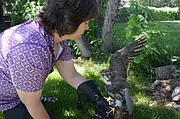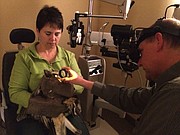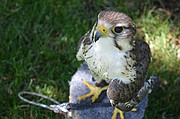Local woman educates on birds of prey
Struck from the sky by a passing car while hunting near the Silver Bullet Bar in Columbia Falls, a young rough-legged hawk was in critical condition when a savior stepped in to help.
Despite the extensive damage done, Kari Gabriel, a raptor rehabilitator in Kalispell, saw some fight left in her new feathered patient and set out to save her.
The road to recovery was long, and, though she suffered no broken bones, the impact caused traumatic head injuries that eventually led to the loss of one of the raptor’s defining features — her eye.
Three years later, the bird, now called Hawkeye, has a permanent home and a new job.
Speaking quietly to warn the vision-impaired predator of her presence, Gabriel opens the door to Hawkeye’s 12-by-12 foot cage. She is greeted with excitement as the bird steps onto her gloved hand, ready to get to work.
Together, Gabriel and Hawkeye travel around the community and beyond to different events and organizations to help educate the public on the importance and purpose of raptors’ roles in the ecosystem.
Gabriel began her work with raptors in at age 28 in Sitka, Alaska, but her fascination with wildlife was sprouting before she learned to read.
Drawn to every kind of creature she could find as a child, Gabriel remembers catching frogs to show her friends and sneaking snakes into school.
Despite young Gabriel’s dream of becoming a veterinarian, her skills took her down a different path, and today she works full time as the director for Flathead Care, a youth empowerment program dedicated to preventing teenage drug and alcohol use. In addition, she is a member of the Kalispell City Council and sells wine on the side.
Still, when she moved to Alaska back in 1991, she felt the familiar call of fur and feathers and began to volunteer with a raptor rescue and rehabilitation center, gaining experience and falling further in love with wildlife.
“Everything about them, for me, is fascinating,” she said. From their acute senses of hearing and sight, to their beauty and intensity as predators, Gabriel said she became enamored with raptors.
In Alaska, as she shadowed under experts handlers and veterinarians, or “bird nerds,” Gabriel worked almost exclusively with bald eagles and eventually became the primary handler of one named Buddy, a bird that had imprinted on humans and could not be released.
With Buddy firmly gripping her arm, Gabriel traveled from state to state, appearing on TV networks, to educate the nation on the creatures she was passionate about. Through her experience with Buddy, Gabriel said she discovered her love of education.
“I love all birds, but I’m specifically fond of raptors. I’ve studied them, and studied them, and studied them,” she said. “I think my favorite thing about them is the training process.”
In 1997, Gabriel moved to Kalispell and, in the three years since bringing Hawkeye home, their feathered family has grown to include two more handicapped raptors.
In the cage next to Hawkeye’s, a smaller gray and white prairie falcon named Jack chirps and squawks as he waits for Gabriel to come for him.
The young bird joined Gabriel’s flock the summer after Hawkeye when he, too, was struck by a car and suffered a broken wing. Though the initial fracture healed thanks to the efforts of local veterinarian Jim Thompson and months of physical therapy, the frantic young bird broke the same wing a second time by flapping and thrashing around in his cage upon returning home.
Today, Jack’s wing has healed, but he’ll never fly well enough to hunt. The way he talks and almost sings when he sees Gabriel, she said he seems content to stay.
More recently, a Saw-whet owl, no bigger than a human fist, also took up permanent residence under Gabriel’s care after suffering two breaks to her right wing during her own bout with a car. Though the owl, named Tink after the famous fairy, is still a bit shy, Gabriel said she shows a lot of potential as an “education ambassador.”
Hawkeye, Jack and Tink will never return to their natural state, but through their new positions, they help raise awareness for their entire species.
“Little animals get their heads stuck in things like yogurt containers and the six pack rings. They’ll get that caught up in their nests, and they’ll hang and die,” Gabriel said. “I teach kids to help the adults in their life learn to pick that stuff up and put it away. We’re educating that next generation, hopefully, to be more conscious of what they’re doing to wildlife.”
Gabriel estimated that as many as 98 percent of the birds she has treated were injured by cars.
“A lot of the time what happens is they’re hunting alongside the road, and they’ll be so focused on that mouse or vole or whatever they’re after that they don’t even notice a car coming,” she said.
Nationally, another problem raptors face is poisoning from lead shot people use to kill animals they prey and scavenge on.
“The percentages are staggering,” she said. “I cannot fathom the reason for not keeping that legislation in place to phase out the use of lead shot.”
Despite her unwavering love for the birds, Gabriel admitted that the cost and process of getting her education and rehabilitation permits as well as feeding and caring for them is high.
Still, she feels that the raptor population and its individuals are worth saving and protecting.
“They take care of rodent populations. They harm no one. They eat critters no one wants in their fields and yards and gardens,” Gabriel said. “They’re so important to our environment, and they’re kind of a barometer for how the environment is doing.”
Gabriel will be taking her three raptors to the Flathead Valley Community College on Wednesday for her next program, called Grandparent College. The program, geared toward kids ages 10 and older and their grandparents, will provide opportunities to experience the birds and offer hands-on activities to help teach attendees more about them and their other raptor cousins.
Sign up is now closed for the Wednesday program, but Gabriel said she is always willing to take her program to anyone with a desire to learn.
For information on future events or to schedule a program visit, contact Gabriel at montanabirdlady@outlook.com.
Reporter Mary Cloud Taylor can be reached at 758-4459 or mtaylor@dailyinterlake.com.








